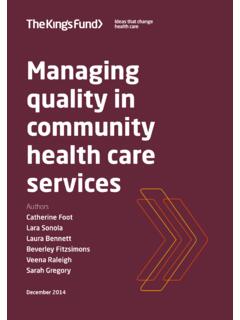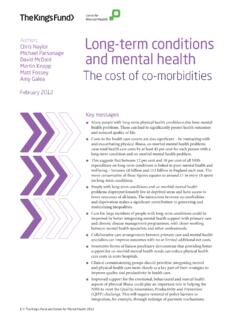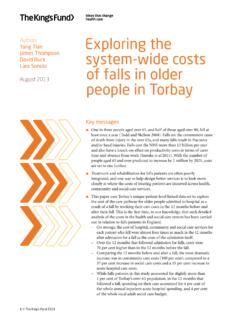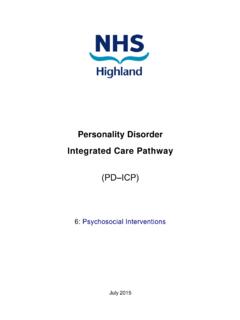Transcription of Bringing together physical and mental health - King's Fund
1 Bringing together physical and mental healthA new frontier for integrated careAuthorsChris NaylorPreety DasShilpa RossMatthew HoneymanJames ThompsonHelen GilburtMarch 2016 Bringing together physical and mental health5671234 Contents 1213 ContentsKey messages 4 Introduction 6 Rising levels of multi-morbidity 8 Inequalities in life expectancy 8 Psychological aspects of physical health 8 Medically unexplained symptoms 9 What does this report add? 10 Getting the basics right: integrated care from a service user perspective 12 Taking a whole person perspective 13 Communication and consultation skills 14Co-ordination of care 15 Proactive care 16 Peer support and self-management 17 Support for family and carers 18 Section summary 19 The case for change: 10 areas where integration is needed most 20 Priority 1: Incorporating mental health into public health programmes 22 Priority 2: Promoting health among people with severe mental illnesses 24 Priority 3.
2 Improving management of medically unexplained symptoms in primary care 26 Contents 2 Bringing together physical and mental health567123445 Priority 4: Strengthening primary care for the physical health needs of people with severe mental illnesses 28 Priority 5: Supporting the mental health of people with long-term conditions 30 Priority 6: Supporting the mental health and wellbeing of carers 32 Priority 7: Supporting mental health in acute hospitals 34 Priority 8: Addressing physical health in mental health inpatient facilities 36 Priority 9: Providing integrated support for perinatal mental health 38 Priority 10: Supporting the mental health needs of people in residential homes 40 Section summary 42 integrated service models: current developments and trends 44 Enhanced support in primary care 45 integrated multidisciplinary teams in the community 50 Liaison psychiatry/psychological medicine services 53 physical health liaison within mental health settings 55 Supported self-management 56 Section summary 56 Implementing change.
3 Overcoming the barriers 58 Leadership 58 Workforce development 60 Finance and commissioning 62 Agreeing outcomes and demonstrating value 64 Harnessing digital technologies 65 Section summary 66 Contents 3 Bringing together physical and mental health567123476 Discussion 67A new frontier for integrated care 67 Achieving the Forward View 68 Implications for professional education and development 69 Beyond parity of esteem 70 Conclusion 71 Recommendations 72 Appendices: case study site profiles 74 Appendix A: 3 Dimensions of care for Diabetes (3 DfD) 74 Appendix B: integrated persistent pain pathway in Oldham 77 Appendix C: City and Hackney Primary care Psychotherapy Consultation Service 80 Appendix D: Oxford Psychological Medicine Service 83 Appendix E.
4 Psychological medicine services in Hull 86 Appendix F: LIFT Psychology in Swindon 89 Appendix G: physical health check protocol for patients with mental health problems in Bradford and Airedale 92 Appendix H: Primary care for secure inpatient units in west London 94 Appendix I: physical health liaison service in Highgate mental health unit 97 Appendix J: integrated perinatal mental health service in Devon 99 References 102 About the authors 117 Acknowledgements 119 Key messages 4 Bringing together physical and mental health5671234 Key messages integrated care initiatives in England and elsewhere have paid insufficient attention to the relationship between physical and mental health .
5 This aspect of integration should be a major part of efforts to develop new models of care in NHS England s vanguard sites and elsewhere. The case for seeking to support physical and mental health in a more integrated way is compelling, and is based on four related challenges: high rates of mental health conditions among people with long-term physical health problems poor management of medically unexplained symptoms , which lack an identifiable organic cause reduced life expectancy among people with the most severe forms of mental illness, largely attributable to poor physical health limited support for the wider psychological aspects of physical health and illness. Collectively, these issues increase the cost of providing services, perpetuate inequalities in health outcomes, and mean that care is less effective than it could be.
6 The first two issues alone cost the NHS in England more than 11 billion annually. The report identifies 10 areas where there is particular scope for improvement. These span the full range of health system activities, illustrating that change is needed across the system. Commissioners and providers can use these 10 areas as a guide to identify where some of the most significant opportunities for quality improvement and cost control lie. Examples of innovative service models described in the report demonstrate that there are opportunities to redesign care in ways that could improve outcomes and may also be highly cost effective. These include various forms of enhanced support in primary care , integrated community or neighbourhood teams, comprehensive liaison mental health services, physical health liaison within mental health services, and integrated perinatal mental health messages 5 Bringing together physical and mental health5671234 All health and care professionals have a part to play in delivering closer integration.
7 Our research with service users and carers highlights the importance of professionals being willing and able to take a whole person perspective, and having the necessary skills to do so. integrated service models can support this by facilitating skills transfer and shifting notions of who is responsible for what. Equally, a great deal of improvement is possible within existing service structures. New approaches to training and development are needed to create a workforce able to support integration of mental and physical health . This has significant implications for professional education; all educational curricula need to have a sufficient common foundation in both physical and mental health .
8 A range of barriers have prevented wider adoption of integrated approaches. These include: separate budgets and payment systems for physical and mental health ; the challenge of measuring outcomes and demonstrating value; and cultural barriers between organisations or groups of professionals. The report describes several enabling factors and practical lessons, including the value of having a board-level champion for physical health in mental health trusts, and vice versa. New payment systems and contracting approaches offer commissioners various options for overcoming some of the financial barriers. In recent years there has been a welcome focus in national policy on achieving parity of esteem for mental health .
9 Colloquially, this phrase has often been interpreted to mean that mental health services should be as good as services for physical health . We argue that there is a greater prize beyond this, in which mental health care is not only as good as but is delivered as part of an integrated approach to 6 Bringing together physical and mental health56712341 Introduction The NHS five year forward view makes the case for what has been called triple integration (Stevens 2015) integration of health and social care , primary and specialist care , and physical and mental health care .
10 The importance of the third of these components has been further emphasised in the report of the independent mental health Taskforce to the NHS in England, which called for the development of integrated care spanning people s physical , mental and social needs ( mental health Taskforce 2016). The purpose of our report is to explore in greater detail what this should and mental health are closely interconnected and affect each other through a number of pathways (see Fig 1) (Prince et al 2007). Throughout this report we take a biopsychosocial perspective, in which health is understood as being a product of biological, psychological and social processes. This is the conceptual framework that many health professionals are trained to work within, but often the principle is not borne out in practice.
















